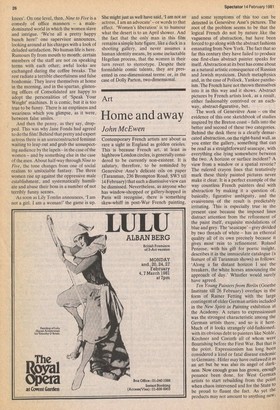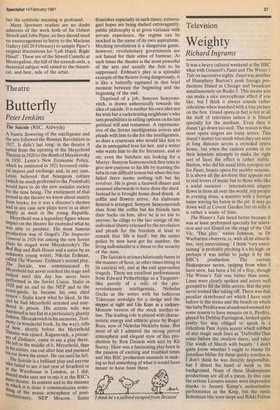Home and away
John McEwen
Contemporary French artists are about as rare a sight in England as golden orioles. This is because French art, at least in highbrow London circles, is generally considered to be currently non-existent. It is salutary, therefore, to be reminded by Genevieve Asse's delicate oils on paper (Taranman, 236 Brompton Road, SW3 till 14 February) that such a dismissive view can be dismissed. Nevertheless, as anyone who has window-shopped or gallery-hopped in Paris will recognise, there is something skew-whiff in post-War French painting, and some symptoms of this too can be detected in Genevieve Asse's pictures. The root of the problem seems to be that the logical French do not by nature like the vagueness of abstraction, but have been forced to go along with the abstract fashions emanating from New York. The fact that so far this century they have failed to produce one first-class abstract painter speaks for itself. Abstraction at its best has come about as a natural artistic consequence of Russian and Jewish mysticism, Dutch metaphysics and, in the case of Pollock, Yankee pantheism. The French have not thrown themselves into it in this way and it shows. Abstract pictures by French artists look, as a result, either fashionably contrived or an eachway, abstract-figurative, bet.
The work of Genevieve Asse — on the evidence of this one sketchbook of studies inspired by the Breton coast — falls into the better and second of these two categories. Behind the desk there is a clearly demarcated abstraction, on the right-hand wall, as you enter the gallery, something that can be read as a straightforward seascape, with everything else lying somewhere between the two. A horizon or surface incident? A view from a window or a spatial reverie? The rulered crayon lines that tentatively mark these thinly painted pictures never make it clear. It is a perfect example of the way countless French painters deal with abstraction by making it a question of, basically, figurative ambiguity, and the evasiveness of the result is predictably irritating. This is especially true in the present case because the imposed lines distract attention from the refinement of the paint itself, exquisite modulations of blue and grey. The 'seascape' — grey divided by two threads of white — has an ethereal quality all of its own precisely because it gives most rein to refinement. Roland Penrose, with his gift for poetic insight, describes it in the immaculate catalogue (a feature of all Taranman shows) as follows: 'Along a far distant horizon I see the breakers, the white horses announcing the approach of day.' Whistler would surely have agreed.
Ten Young Painters from Berlin (Goethe Institute till 26 February) overlaps in the form of Rainer Fetting with the large contingent of older German artists included in the New Spirit in Painting exhibition at the Academy. A return to expressionism was the strongest characteristic among the German artists there, and so is it here. Much of it looks strangely old-fashioned, with its obvious debt to painters like Nolde, Kirchner and Corinth all of whom were flourishing before the First War. But that is the point. Expressionism has long been considered a kind or fatal disease endeanc to Germany. Hitler may have outlawed it as an art but he was also its angel of darkness. Now enough grass has grown, enough penance been done, for West German artists to start rebuilding from the point when chaos intervened and for the State to be proud to flaunt the fact. As yet the products may not amount to anything new, but the symbolic meaning is profound.
Many Spectator readers are no doubt admirers of the work both of Sir Osbert Sitwell and John Piper, se they should need no encouragement to hurry to the Maclean Gallery (till 20 February) to sample Piper's original illustrations for 'Left Hand, Right Hand!'. These are of the Sitwell Castello at Montegufoni, the hill of the screech-owls, a theatrical subject well suited to the theatrical, and best, side of the artist.







































 Previous page
Previous page